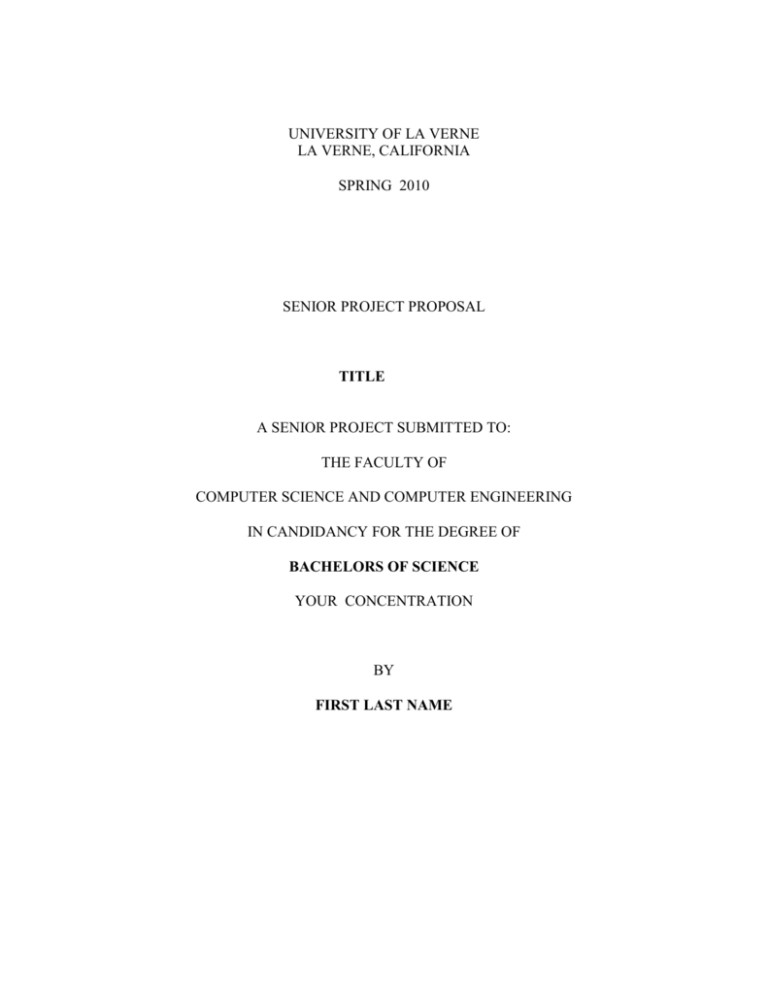Senior Project Proposal Outline
advertisement

UNIVERSITY OF LA VERNE LA VERNE, CALIFORNIA SPRING 2010 SENIOR PROJECT PROPOSAL TITLE A SENIOR PROJECT SUBMITTED TO: THE FACULTY OF COMPUTER SCIENCE AND COMPUTER ENGINEERING IN CANDIDANCY FOR THE DEGREE OF BACHELORS OF SCIENCE YOUR CONCENTRATION BY FIRST LAST NAME Table of Contents 1. Personal background.................................................................................................... 1 2. Introduction ................................................................................................................. 1 3. Organizational overview.............................................................................................. 1 4. Problem statement and the scope of the project .......................................................... 1 5. Description of the current system ................................................................................ 1 6. Requirements for the proposed system design ............................................................ 1 7. Implementation plan .................................................................................................... 2 8. Request for support from the company if needed........................................................ 2 9. Development time frame and cost ............................................................................... 2 10. Primary contact person include .................................................................................... 3 11. Approvals ..................................................................................................................... 3 Draft 1 1 1. Personal background Include who you are, your concentration and why you got interested in the topic. Use the first person reference only in this section. The remaining section should have the third person references. 2. Introduction . What is your proposal about? 3. Organizational overview If you are working and the project is going to be implemented in the company, provide some information about the company. 4. Problem statement and the scope of the project A problem statement should describe the problem, describe its causes, and identify potential approaches or solutions to the problem through the use of literature reviews. So, explain the current problem(s) and how your project will solve it, define the goal and the scope of your project. 5. Description of the current system a. Explain the current hardware/software used by the company b. Provide the website link if you are going to improved the website/web design etc. c. Include if appropriate for your project: Underlying business processes Hardware Software (application and system) System processes Information System interfaces 6. Requirements for the proposed system design a. Include if appropriate for your project: Underlying business processes Hardware Software (application and system) System processes For example: John Smith 3/6/2016 Draft 1 2 Information System interfaces Software tools needed Functional requirements 7. Implementation plan Use software engineering techniques and computer science principles to develop software as follows: 1. Analyzing of specifying requirements. These requirements include software, hardware, physical, and functional requirements. Designing a software or hardware or information solution to the requirements specification. Use the functional flowchart to describe the functional requirements. 2. Implementing the design. Describe how the objectives will be achieved and the tasks you will perform. 3. Testing and integrating (the programs or device components). Describe what will be tested and how. 4. Writing the required documents e.g. user manual or training manual. 5. Illustrate a project in action if the demo is accessible. 6. Submitting complete documentation, the software and the hardware description. Examples of software development projects are: web design, web applications, software development aids, user interface tools, Internet applications, and various business or scientific application programs. Some development projects may interact with a special hardware environment. Examples are: program debuggers, device drivers, network systems, code generators and linkage editors. 8. Request for support from the company if needed a. Hardware b. Software c. Need to learn and study 9. Development time frame and cost The schedule is a significant part of the project. It defines what you intend to do and when you plan to do it. You should consider how long each activity will take, which activities must precede others, and how much overlap is possible or desirable. The schedule identifies tasks to be performed, milestones to be met, and the estimated number of hours for each task. For example: John Smith 3/6/2016 Draft 1 3 Example Project Schedule 2010 1 Tasks: February 2 3 4 1 March 2 3 4 1 April 2 3 4 1 2 May Summary 3 4 5 Ho Percent urs Studying and Specifying Requirements 12 12 8 6 38 17.90% Design 4 6 12 8 30 14.20% Implement 4 8 12 6 5 5 5 5 50 23.00% Unit Test &Integrate & Test 4 6 7 7 7 7 8 46 22.30% Write User’s Manual 6 8 14 6.60% Write Final Report 6 12 12 30 14.20% Presentation 4 4 1.90% Hours 12 12 12 12 16 16 16 12 12 12 12 12 14 14 12 12 4 212 100.00% 10.Primary contact person include Name Address Phone number E-mail 11. Approvals 1. Name: Prof. Seta Whitby Signature: ________________Date_______ 2. Name: Prof. Ray Ahmadnia Signature: ________________Date_______ 3. Name: Prof. Jozef Goetz Signature: ________________Date______ Please read the Final_Report_Template.doc before preparing this document and try to reuse the above document later when you prepare the Final_Report_Template.doc. Format 1. Spacing: For example: John Smith 3/6/2016 Draft 1 4 The standard margins should be used for each page (1 inch for top and bottom, 1.5 inch on the left and 1 inch on the right). Use the 12-point type. 2. Justification The body of the paper should be either left-justified of fully-justified. The section headings should be on separate lines, with one line above and below each heading. The sub-section headings should be left-justified, with one line above each sub-section heading. 3. Font size The acceptable font size for the body is 12 points. Section headings should be 14-points, bold-faced, in the same font as the body of the paper. Sub-section headings should be 12-points, bold-faced, in the same font as the body of the paper. Use the Times New Roman font type. For example: John Smith 3/6/2016









